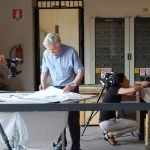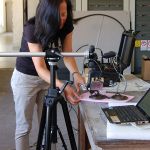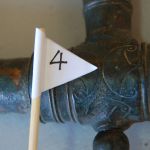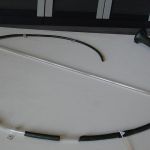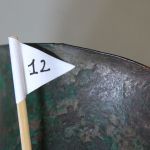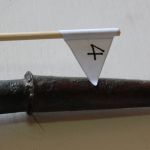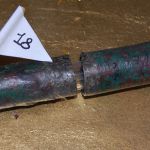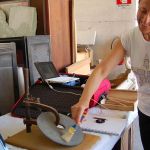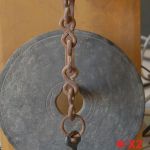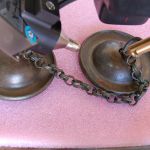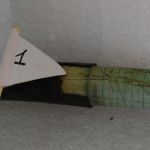
August 4-6, 2015
Naples, Archaeological Museum: analysis of metal musical instruments from Pompeii (five cornua, one tibia, one discus, one pair of cymbals and fragments of tibia)
The musical instruments, stored in the Archaeological Museum of Naples, were analysed by X-ray fluorescence (XRF) spectroscopy in a totally non-invasive modality and without any treatment of the surfaces, in order to characterize the compositions of the metal alloy (Fig. 1). The objects were observed with the aid of a video microscope operating at magnification 50x and 200x.
The analysis was performed by Giorgia Agresti and Claudia Pelosi in the presence of the museum attendants. Moreover, the points for the XRF analysis were selected together with Peter Holmes and Alessandro Ervas, who also collected further technical information on the cornua, in order to produce an exact copy of this instrument (Fig. 2).
Main results
Each cornu was carefully examined by analysing the fittings, the tube, the bell, the mouthpiece and the solders (Figs. 3-7). The alloys utilised in the tube and bell are made up of copper and tin, with a tin content of around 1-2%. Fittings show different compositions: some are made of bronze and other of brass with zinc content from 8 to 17%. Fitting contain also lead, which in cornu MANN 286789 reaches values of 18%. Solders are made from copper, lead and zinc (about 4-5%). Mouthpiece and receivers (when present) have high counts of zinc. The presence of brass alloy for solders suggests a sophisticated technological ability in creating these musical instruments.
The analysis of discus (MANN 78621, Figs. 8-10) revealed the presence of bronze alloy in the disc (with about 3% of tin) and in the clapper (tin about 1-2%). The latter element contains also lead (about 7%).
The XRF analysis on cymbals was performed on several points of the base, of the bell and of the chain that joins the two parts of the instrument (Fig. 10). The alloy of the cymbals is made of bronze with about 1% of tin. Lead was also detected with higher percentages in one cymbal (until 14%) in respect to the other one (about 1-2%). The chain is made of copper-rich bronze alloy.
Finally, the analysis of tibia fragments (MANN 76891) revealed the presence of bone in the inner part of the instrument (Fig. 11), of bronze alloy in the tube with about 1% of tin, and silver in the mouthpiece (Figure 12). The solder is composed of copper (about 94%), lead (about 3%) and tin (about 2%).
Figure 1 – XRF setup
Figure 2 – Working area set in the Museum of Naples and the staff involved
Figure 3 – Analysis of the fitting in cornu MANN 5653: working phase during which the point of analysis is carefully documented by photograph and marked by a number.
Figure 4 – XRF measurement on the tube of cornu MANN 5652
Figure 5 – XRF measurement on the bell of cornu MANN 1277
Figure 6 – XRF measurement on the mouthpiece of cornu MANN 5652
Figure 7 – XRF measurement on a solder in cornu MANN 286789
Figure 8 – Preparing the discus for XRF analysis
Figure 9 – Points of XRF analysis on the discus MANN 78621
Figure 10 – XRF analysis on cymbals MANN 76943
Figure 11 – XRF analysis on the inner part of tibia MANN 76891
Figure 12 – XRF analysis on the silver mouthpiece of tibia MANN 76891
Naples, Archaeological Museum: analysis of metal musical instruments from Pompeii (five cornua, one tibia, one discus, one pair of cymbals and fragments of tibia)
The musical instruments, stored in the Archaeological Museum of Naples, were analysed by X-ray fluorescence (XRF) spectroscopy in a totally non-invasive modality and without any treatment of the surfaces, in order to characterize the compositions of the metal alloy (Fig. 1). The objects were observed with the aid of a video microscope operating at magnification 50x and 200x.
The analysis was performed by Giorgia Agresti and Claudia Pelosi in the presence of the museum attendants. Moreover, the points for the XRF analysis were selected together with Peter Holmes and Alessandro Ervas, who also collected further technical information on the cornua, in order to produce an exact copy of this instrument (Fig. 2).
Main results
Each cornu was carefully examined by analysing the fittings, the tube, the bell, the mouthpiece and the solders (Figs. 3-7). The alloys utilised in the tube and bell are made up of copper and tin, with a tin content of around 1-2%. Fittings show different compositions: some are made of bronze and other of brass with zinc content from 8 to 17%. Fitting contain also lead, which in cornu MANN 286789 reaches values of 18%. Solders are made from copper, lead and zinc (about 4-5%). Mouthpiece and receivers (when present) have high counts of zinc. The presence of brass alloy for solders suggests a sophisticated technological ability in creating these musical instruments.
The analysis of discus (MANN 78621, Figs. 8-10) revealed the presence of bronze alloy in the disc (with about 3% of tin) and in the clapper (tin about 1-2%). The latter element contains also lead (about 7%).
The XRF analysis on cymbals was performed on several points of the base, of the bell and of the chain that joins the two parts of the instrument (Fig. 10). The alloy of the cymbals is made of bronze with about 1% of tin. Lead was also detected with higher percentages in one cymbal (until 14%) in respect to the other one (about 1-2%). The chain is made of copper-rich bronze alloy.
Finally, the analysis of tibia fragments (MANN 76891) revealed the presence of bone in the inner part of the instrument (Fig. 11), of bronze alloy in the tube with about 1% of tin, and silver in the mouthpiece (Figure 12). The solder is composed of copper (about 94%), lead (about 3%) and tin (about 2%).
Figure 1 – XRF setup
Figure 2 – Working area set in the Museum of Naples and the staff involved
Figure 3 – Analysis of the fitting in cornu MANN 5653: working phase during which the point of analysis is carefully documented by photograph and marked by a number.
Figure 4 – XRF measurement on the tube of cornu MANN 5652
Figure 5 – XRF measurement on the bell of cornu MANN 1277
Figure 6 – XRF measurement on the mouthpiece of cornu MANN 5652
Figure 7 – XRF measurement on a solder in cornu MANN 286789
Figure 8 – Preparing the discus for XRF analysis
Figure 9 – Points of XRF analysis on the discus MANN 78621
Figure 10 – XRF analysis on cymbals MANN 76943
Figure 11 – XRF analysis on the inner part of tibia MANN 76891
Figure 12 – XRF analysis on the silver mouthpiece of tibia MANN 76891
Photographs of the Laboratorio "Michele Cordaro" team in Naples (Italy) - (Photographer: Claudia Pelosi)



